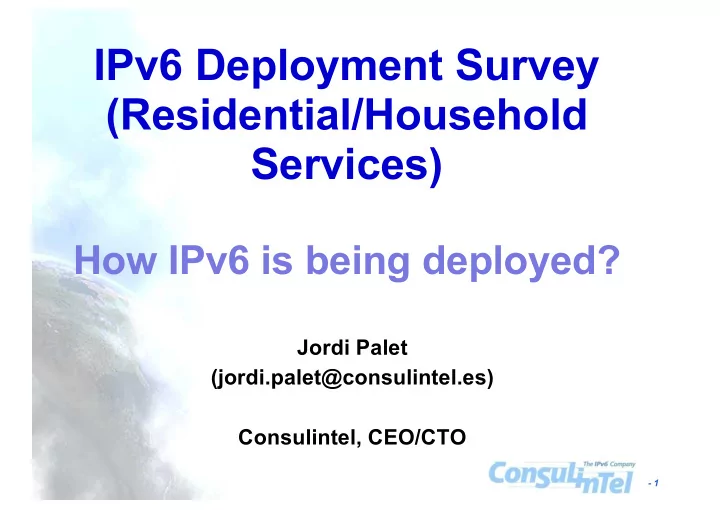

IPv6 Deployment Survey (Residential/Household Services) How IPv6 is being deployed? Jordi Palet (jordi.palet@consulintel.es) Consulintel, CEO/CTO - 1
Survey Contents • Basic ISP data (name, country, RIR) • Technology of the customer link • Is it a commercial service or a “pilot” • IPv6 WAN link • IPv6 customer addressing • IPv4 service • Transitioning and provisioning • IPv6 DNS services • Other data (optional contact details) Note: Survey not intended for service to mobile phones, however, 2G/3G/4G response can be provided for service via a “CPE/modem” - 2
- 3
Who is responding? • Looking at whois … • ISP employees – From their own network most of the time • Customers – Most of the time from their own residential networks • Most of the responder “networks” have both IPv4 and IPv6 allocations – Responding with IPv4 from ISP network probably means, even if they have deployed IPv6 to residential customers, may be not in (all) the corporate LANs. • Other observations, looking at bind and apache logs: – Happy-eye-balls timeout … – Is that anymore needed? Time to retire it? – Hiding IPv6 network problems? - 4
- 5
- 6
Regional/Country analysis • Is this meaning there are some regions/countries with a higher degree of residential deployment? – APNIC (Australia, China, Japan, Malaysia, New Zealand). Missing responses from Korea. – ARIN (US, Canada) – LACNIC (Argentina, Brazil, Colombia, Guatemala, Paraguay, Peru, Venezuela). Missing responses from Ecuador and Mexico. – RIPE NCC (Belgium, Denmark, Finland, France, Germany, Greece, Luxembourg, Netherlands, Norway, Portugal, Romania, Russia, Slovenia, Spain, Sweden, Switzerland, UK) • Or instead regions/countries not doing it? – AfriNIC – LACNIC - 7
- 8
Deployment differences by techology • More deployment by “newer” technologies: – FTTH – xDSL – Cable/DOCSIS – Wireless (WiFi, LMDS, WiMax, …) • à Avoids investing in replacing CPEs • Are there problems/dificulties with some specific access technologies? – According to the responses, I don’t think so … • Vendor or transition technologies issues with some access technologies? – Nothing reported - 9
- 10
Why still not commercial? • 51% responses –> No Answer, mainly customers or even employees of ISPs which really don ’ t know. • 32% Yes, already commercial • 17% No commercial -> checked with some of the responders, they will go to commercial, typically it is a trial, but they plan to deploy (few months from now) - 11
- 12
WAN prefix issues • Remarkable -> /64 60% • What means other? – /128, /62, /60, /56, /48, /32 ... No comments • Why not stable (11%)? -> Note 70% no answer – Provisioning systems? • 63% using GUA • Interesting figures about using the /64 from the customer allocated prefix • Distribution of those technical aspects not related to any specific country/region - 13
- 14
LAN prefix issues • What are the “other" sizes? – A few /60 and /62 (others … /29, /44, /57, /127, /128) – Surprising (1) response -> shared /64 • Are we doing right/wrong? It is related to specific regions or countries? – 32% /64 mainly in LACNIC, some countries in APNIC – 36% /56 ARIN/RIPE NCC – 22% /48 mainly “more advanced” countries (Australia, New Zealand, Germany, Finland, Denmark, France, UK, China, Japan) • Are we realizing that services work better with “stable” addressing? – AfriNIC, RIPE NCC and APNIC mainly stable – ARIN mainly not-stable – LACNIC half and half • Why not allowing stable even as an “extra”? – Training issues? IPv4 mind-set? – Extra cost, very few - 15
- 16
- 17
Transition and IPv4 issues • It is a trend not providing IPv4 in the access? – It means some transition technologies being used which don’t require IPv4 in the access. • Not related to specific regions/countries • What other “transition” technologies? – Actually none, just ”bad answers” • CGN deployment increasing? - 18
- 19
DNS • Seems to follow “LAN IPv6 stable prefix” • Reverse DNS as an extra service? - 20
Conclusions • In general “correct” deployment – Some exceptions • Misunderstandings on IPv6 technology/marketing/other reason: – IPv6 prefix size – Stability of prefix • More “advanced” countries seem to do it smartly, less ”misunderstandings” - 21
Thanks !! Survey link: http://survey.consulintel.es/index.php/175122 Contact: – Jordi Palet (Consulintel): jordi.palet@consulintel.es - 22
Recommend
More recommend